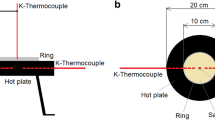Abstract
The paper gives details of frost heave tests carried out on burnt and on unburnt colliery shales, the samples being obtained from 19 collieries in various parts of the country.
Whereas 11 of the 12 burnt shales tested were frost susceptible, this was the case for only 4 of the 17 unburnt samples and the relative behaviour of the two forms of shale is attributed to differences in absorption and in the amount and nature of the fine material present.
A limited study of the test conditions suggests that heave increases with increase in specimen moisture content at the time of compaction, with decrease in specimen dry density and with decrease in maximum particle size.
Recommendations are included for changes in the current test procedure and in the interpretation of the results.
Résumé
On décrit des essais de gonflement au gel réalisés sur des schistes houillers calcinés et non calcinés, avec des échantillons provenant de 19 houillères de différentes régions.
Si 11 des 12 schistes calcinés se sont révélés susceptibles au gel, cela n'a été le cas que pour 4 des 17 échantillons non calcinés: cet écart de comportement entre les deux formes de schiste est attribué à des différences d'absorption, ainsi que de quantité et de nature des fines présentes.
Une étude limitée des conditions d'essai suggère que le gonflement s'accroît avec l'augmentation de la teneur en humidité de l'échantillon au moment du compactage, avec la diminution de la dinsité sèche de l'échantillon et avec la diminution de la dimension maximale des particules. Cette étude s'accompagne de recommandations pour la modification de la méthode d'essai habituelle et l'interprétation des résultats.
Similar content being viewed by others
References
ROAD RESEARCH LABORATORY.—Road Note 29, third edition.A guide to the structural design of pavements for new roads. HMSO, 1970.
DEPARTMENT OF THE ENVIRONMENT.—Specifacation for road and bridge works. HMSO, 1969.
Croney D., Jacobs J. C.—The frost susceptibility of soils and road materials. TRRL Report LR 90, Crowthorne, 1967.
Kettle R. J., Williams R. I. T.—Cement stabilised unburnt colliery shale. Roads and Road Construction, Vol. 47, No. 559, 1969, pp. 200–206.
Kettle R. J.—Freezing behaviour of colliery shale. Ph. D. thesis. University of Surrey, 1973.
Turrill A. D.—A study of the variability in frost heave testing. M. Sc. Project, University of Surrey, 1972.
Taber S.—Frost heaving. J. of Geology, Vol. 37, No. 5, 1929, pp. 428–461.
Taber S.—Discussion frost heaving in Proceedings Highway Research Board, Vol. II, 1932, pp. 173–177.
Martin R. T.—Rhythmic ice banding in soil. Highway Research Board Bulletin, No. 218, 1959, pp. 11–23.
Gutt W et al.—A survey of the locations, disposal and prospective uses of the major industrial by products and waste material. BRE Current paper. CP 19/74, 1974.
Lake J. R.—Unburnt colliery shale-its possible use as a road fill material. TRRL Technical Note TN317 (revised), 1968 (not for publication).
MINISTRY OF TRANSPORT.—Use of unburnt colliery shale as filling material in embankments. Technical Memo T4/68, 1968.
DEPARTMENT OF THE ENVIRONMENT.—Use of unburnt colliery shale as filling material in embankments. Technical Memo H4/74, 1974.
Kettle R. J., Williams R. I. T.—The development of frost heave testing equipment. Materials and Structures, Vol. 6, No. 34, 1973, pp. 299–306.
BRITISH STANDARDS INSTITUTION.Methods of testing soils for civil engineering purposes. B.S. 1377. 1967, London, 1967.
BRITISH STANDARDS INSTITUTION.—Aircolled blastfurnace slag-coarse aggregate for concrete. B.S. 1047. 1952, London, 1952.
NATIONAL COAL BOARD.—Technical Memorandum relating to B.S. 1377. 1967.Methods of testing soils for civil engineering purposes. Fourth draft. N.C.B. Joint Working Party on Soil Mechanics Testing, Coal House, Harrow, Middlesex, 1970.
Bjerrum L., Hoder J.—Measurement of the permeability of compacted clays. Proceedings of the fourth International Conference on Soil Mechanics and Foundation Engineering, Vol. 1, Butterworth's, London 1957, pp. 6–8.
Penner E.—Heaving pressure in soils during unidirectional freezing. Canadian Geotechnical Journal, Vol. 4, No. 4, 1967, pp. 398–408.
Dumbleton M. J.—The classification and description of soils for engineering purposes: a suggested revision of the British system. TRRL Report LR 182, Crowthorne, 1968.
Casagrande A.—Effects of frost in soil. Permanent International Association of Road Congresses, first and second section combined 8th Congress. The Hague, 6th Question, 1938, pp. 10–11.
Croney D.—Some cases of frost damage to roads. Road Note No. 8. Department of Scientific and Industrial Research, HMSO, London, 1949.
AARCTIC CONSTRUCTION-AND FROST EFFECTS LABORATORY.Cold room studies, third Interim report of investigations. Technical Report 43, Vol. 1 and 2. U.S. Army Corps. of Engineers, ACFEL, Walthan, Mass., 1958.
Win H. F., Rutledge P. C.—Frost action in highway bases and subgrades. Purdue University Engineering Bulletin, Vol. 24, No. 2, 1940.
Linell K. A., Kaplar, C. W.—The factor of soil and material type in frost action. Highway Research Board Bulletin. No. 225, 1958, pp. 81–128.
SCOTTISH DEVELOPMENT DEPARTMENT.—Testing of road materials for frost susceptibility. Technical Memorandum, SH7/72, 1972.
Taber S.—Freezing and thawing of soils as factors in the destruction of road pavements. Public Roads, Vol. 11, No. 6, 1930, pp. 113–132.
Kaplar C. W.—Phenomenon and mechanism of frost heaving. Highway Research Board Record, No. 304, 1970, pp. 1–13.
Author information
Authors and Affiliations
Rights and permissions
About this article
Cite this article
Kettle, R.J., Williams, R.I.T. Frost heave testing. Mat. Constr. 9, 99–107 (1976). https://doi.org/10.1007/BF02473865
Issue Date:
DOI: https://doi.org/10.1007/BF02473865




